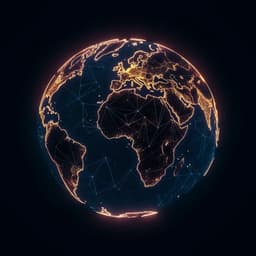
Environmental Studies and Forestry
Strong versus weak sustainable development in the blue economy: a study of 15 EU coastal countries
C. Spenger, I. S. Gonzatti, et al.
This paper examines the strides made towards sustainable marine development across 15 EU coastal countries over the last decade by utilizing SDG 14 indicators. The research, conducted by Christoph Spenger, Ignacio Saldivia Gonzatti, Lennard Kröger, Christopher Robin Fleet, Rudi Voss, and Wilfried Rickels, reveals a diverse landscape of sustainable progress, with some nations achieving strong sustainability while others lagged behind.
~3 min • Beginner • English
Introduction
The paper addresses how to measure and compare sustainable marine development—encompassing ocean health and the blue economy—across EU coastal countries. Motivated by EU policy alignment with SDG 14 and the need for country-level diagnostics to design efficient policies, the study distinguishes between weak sustainability (high substitutability across dimensions) and strong sustainability (limited substitutability; emphasis on balanced performance). Existing SDG 14 monitoring suffers from sparse coverage, aggregation at regional levels, and limited temporal depth, hindering robust national assessments. The authors propose an expanded, SDG14-guided, country-level indicator framework to evaluate status and progress (2012–2022) for 15 EU coastal states, explicitly contrasting weak and strong sustainability to reveal balance vs. imbalance in blue growth trajectories.
Literature Review
The authors review several monitoring efforts and their limitations. The UN SDG indicator database has poor country/time coverage for SDG 14. Eurostat’s EU SDG monitoring includes only six indicators covering four of the ten SDG 14 targets and often uses regional aggregates, limiting country-level assessments. The Sustainable Development Report includes six indicators over three targets with data typically ending in 2019 or earlier. The OECD assessment largely mirrors the UN framework, inheriting its data gaps, with only half the targets monitored and time series available for two. Other EU-focused studies rely on the Eurostat set, similarly constrained. The Ocean Health Index (OHI) and the Baltic Health Index (BHI) offer ecosystem health assessments but provide limited insight into balanced development across socio-economic and ecological dimensions. Thus, the literature lacks a comprehensive, indicator-rich, country-level framework to assess SDG 14 that can differentiate between weak and strong sustainability.
Methodology
Scope and data: The study assesses 15 EU coastal countries in the Baltic, North Sea, and Atlantic over 2012–2022, using SDG 14 (targets 14.1–14.7, 14.a, 14.b, 14.c) as the organizing framework. At least two indicators per target (except 14.c) are selected or developed, totaling 22 indicators, with data from CMEMS, EEA, Eurostat, GI-TOC, ICES, IMO, IUCN, OECD, and OHI. Three time points are emphasized (2012, 2016, and most recent 2018–2022), with all data and code shared via OSF.
Indicator selection: Preference is given to reliable, long-horizon, policy-relevant indicators aligned with SDG 14 but improved to better capture pressures and responses at country level. Official UN indicators are often unsuitable due to binary/categorical formats and data gaps; two official indicators (Key Biodiversity Areas, Marine Research) are included. Fisheries metrics rely on ICES stock-level data: 8 (FMSY/F), 9 (B/BMSY), 14 (TAC/Catch), 19 (SAD/TAC). Catch-weighted averages attribute stock states/pressures to countries; for B/BMSY a 7-year moving average accounts for lagged effects of past catches. Depending on year and indicator, 52–75 stocks are included.
Target setting and normalization: Indicators are transformed to ratio-scale, fully comparable scores in [0–100] via difference-to-target normalization. Targets are set using: (1) uniform external targets when available (e.g., MPA coverage target of 20–30%; maximum number of IMO protocols); (2) system-consistent scientific targets (e.g., MSY reference points; pre-industrial pH); and (3) a best-practice benchmark (average of top three EU performers after outlier removal) when no explicit target exists. This approach avoids dependence on dataset extrema and eases interpretation.
Aggregation and sustainability concepts: A nested generalized mean (social choice theory) aggregates indicators to targets and targets to the SDG 14 goal. Substitution elasticities differ by level to reflect complementarity across dimensions. Weak sustainability assumes perfect substitutability (arithmetic mean; σ→∞). Strong sustainability restricts substitution (σ≤1), implemented via Monte Carlo with σSDG~U(0,1) (N=10,000) and σtarget set to 0.5+ (strong) or 10^6 (weak within-target). Strong-sustainability scores emphasize balance and penalize left-tail underperformance.
Trend analysis: Progress is assessed by score changes (ΔCI between 2012 and most recent) and by average annual growth rates estimated from log-linear regressions of indicator scores against time, using all available points (2012–2023). Slopes are aggregated with arithmetic means (weak sustainability) to classify countries by status vs. progress.
Key Findings
- Indicator status (most recent): Performance is heterogeneous across targets. Countries generally score higher in 14.2 Ecosystem-based management, 14.4 Sustainable fishing, 14.b Small-scale fishing, and 14.c Marine agreements, but lower in 14.1 Pollution and 14.7 Economics. Some indicators show wide dispersion (e.g., eutrophication, Natura 2000/MPA, marine research) and outliers (e.g., subsidies where Latvia scored 100 in 2019 due to no high-risk subsidies).
- Indicator development (2012→most recent): 13 of 22 indicators improved. Largest improvement: 4 Maritime Spatial Planning (broad MSP implementation). Largest decline: 16 Economies (blue economy GVA growth), influenced by COVID-19; coastal tourism GVA fell 44% from 2019 to 2020. Ecologically salient declines include 2 Eutrophication and 11 Habitat. Fisheries are mixed: 8 FMSY/F improved; 9 B/BMSY slightly decreased, likely reflecting lagged biomass responses to earlier higher fishing mortality. 19 SAD/TAC (adherence to scientific advice) worsened, while 14 TAC/Catch (quota compliance) improved.
- Aggregated rankings (most recent): Rankings differ under weak vs strong sustainability. Estonia ranks 1st under both. France ranks 3rd (weak) but 11th (strong), indicating imbalance (second-largest spread across targets). Germany ranks 5th (weak) and 3rd (strong), reflecting balanced performance (low spread). Last place: Finland under weak; Sweden under strong.
- Development classification (2012→most recent): Seven countries improved under both concepts; leaders include Estonia, Lithuania, and Poland. Seven countries improved only under weak sustainability, indicating gains coupled with increased imbalance; France and Sweden notably drop under strong assumptions. The Netherlands is the only country not improving under either concept.
- Status vs progress (trend): Estonia has the highest status and fastest progress, driven by reductions in eutrophication and increased plastic recycling, plus strong scores in 14.2 and 14.b. Ireland is catching up, aided by substantial decreases in high-risk fisheries subsidies (2014–2018) and higher coastal employment shares (15a). Portugal progresses quickly (e.g., higher IMO participation, improved FMSY/F) but is constrained by low scores in 14.1 (high eutrophication and plastic generation) and 14.5 (low MPA coverage). Germany is losing momentum due to missed GVA growth in maritime transport and coastal tourism (60% of its blue economy GVA). The Netherlands is falling behind, with deteriorations in subsidies (higher IUU-risk share), livelihoods (drop in GVA per hour), artisanal fishing, and eutrophication.
- Cross-comparison with OHI/BHI: OHI scores are generally higher or equal to SDG14 scores (except Belgium). Differences (e.g., higher OHI scores for Sweden, Finland, Spain) may reflect OHI goals like Iconic species, not distinguished in SDG14. Greater variability relative to BHI highlights tension between global SDGs and regional needs.
Discussion
The study demonstrates the value of distinguishing weak from strong sustainability to expose imbalances masked by compensability. Findings suggest EU countries overall progress toward sustainable marine development, but balance varies substantially. Methodologically, the work tackles common index-design challenges: indicator selection under data constraints, normalization choices, and aggregation rules. The authors emphasize that selection tends to prioritize available, policy-relevant measures and may underrepresent social equity dimensions; many SDG 14 official indicators are binary/categorical or sparse. Country-level aggregation can obscure eco-regional heterogeneity (e.g., struggling Baltic stocks).
Normalization to targets enhances interpretability but embeds ambition levels; some targets (e.g., nutrient balance) are highly ambitious, yielding low scores, while others (e.g., TAC/Catch) reflect minimum compliance and yield uniformly high scores. Fisheries evidence underscores mixed real-world outcomes despite improved fishing mortality; shifting reference points (ICES benchmarks) can mask ecosystem-driven productivity changes and contribute to shifting baselines. The authors argue for multiple complementary indices and iterative comparison to improve robustness, accountability, and policy learning. Introducing strong vs weak sustainability adds methodological insight by quantifying performance balance across dimensions, offering guidance on which targets require attention for countries with unbalanced development.
Conclusion
The paper introduces a comprehensive, SDG14-based, country-level assessment for 15 EU coastal states (2012–2022), expanding indicator coverage (22 indicators across nearly all SDG 14 targets), employing target-based normalization, and a nested generalized-mean aggregation to contrast weak and strong sustainability. Empirically, the EU exhibits progress in sustainable marine development but unevenly: seven countries advance under both weak and strong sustainability, seven only under weak, and one (the Netherlands) under neither. The approach highlights where development is unbalanced and informs policy prioritization. The authors recommend continued refinement of indicators (including effectiveness measures, social equity dimensions, and improved fisheries and protection metrics), broader data availability and quality, and the use of multiple indices to triangulate trends. They caution that EU rankings reflect relative performance and pressures within the region and do not equate to global burden contributions.
Limitations
- Data availability and quality: Many official SDG 14 indicators are binary/categorical or sparse, limiting inclusion. The ‘country first’ approach prioritizes official data that may be unreliable (e.g., catches, subsidies). International comparability varies in quality and standards.
- Coverage gaps: Not all aspects of targets can be measured; e.g., 14.a Marine Science is proxied by marine technology research share, missing broader objectives (transdisciplinary, societal relevance). Effectiveness of protected areas is not captured, only coverage and key biodiversity areas.
- Aggregation scale: Country-level indicators can obscure eco-regional disparities (e.g., Baltic Sea stock collapses, small-scale fisheries stress).
- Normalization choices: Difference-to-target embeds ambition; some targets are stringent (yielding low scores), others reflect minimum compliance (yielding high scores). Endogenous best-practice targets may still be contentious.
- Fisheries reference dynamics: ICES benchmark adjustments to FMSY/BMSY can blur long-term ecosystem changes and contribute to shifting baselines, potentially misaligning scores with ecological reality.
- Social equity: The framework largely emphasizes blue growth and intergenerational equity, with limited coverage of intragenerational equity and social justice within the economic dimension.
- Indicator count per target: While improved over the UN framework, some targets still have limited indicators; 14.c remains with fewer measures, which can bias composite results.
Related Publications
Explore these studies to deepen your understanding of the subject.







